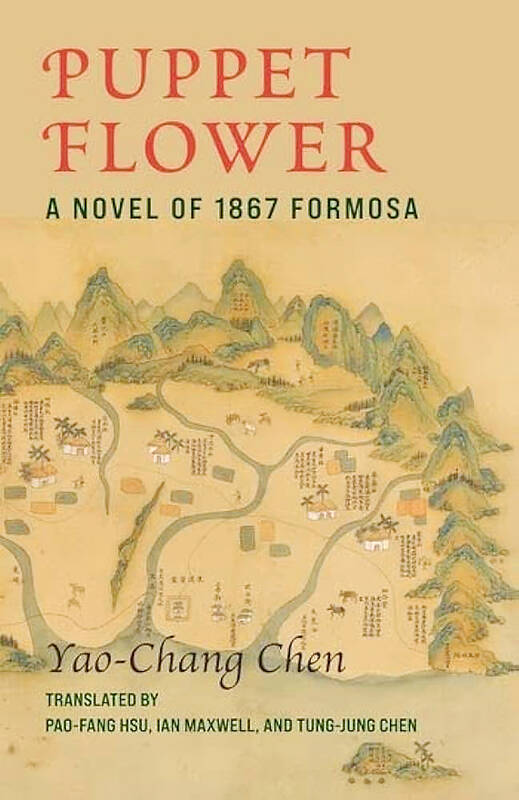This novel begins with a ship-wrecked crew off southern Taiwan in 1867 being attacked on the beach by the local inhabitants. This ill-fated crew were mostly Americans and described by the Taiwanese as “red-hairs.” One of those killed on landing was a woman.
Back in China, the American vice-consul in Amoy was one Le Gendre, married to Clara. His responsibilities lay in Amoy plus four other locations on Formosa (Taiwan) — Tamsui, Anping, Keelung and Takao. Anping was the port of Tainan, at the time the most important city on the island.
Chen Yao-chang (陳耀昌) is the celebrated author of this work, but he didn’t publish his first novel until he was in his sixties. Trained in medicine, he became a professor and the director of the Stem Cell Research Center before turning to writing historical fiction. He also served as a Democratic Progressive Party (DPP) representative in the Taiwan National Assembly.

The year 1867 is a significant, if unrecognized, one in Taiwan’s history, for reasons that will become clear later.
Ethnic complexity abounds in this novel. Two of the leading protagonists, Butterfly and her brother Bunkiet, have a Hakka father and aboriginal mother, while even Le Gendre is a French-born American who has spent most of his life in Japan, Korea, China and Taiwan. Butterfly’s relationship with Le Gendre is a metaphor for Taiwan’s growing relationship with the wider world, independent and Chinese.
This novel appeared on Taiwan Public Television in 2021 in a 12-episode mini-series.
This English-language version is the work of Hsu Pao-fang, a seasoned translator, Ian Maxwell, a graduate of Lancaster University who lives and works in Taipei, and Chen Tung-jung, a retired professor of English.
The author admits early on that he experienced problems with place and other names because of the multiplicity of local variants. Many of the forms opted for derive from Le Gendre’s Notes of Travel in Formosa.
“Puppet savages” was a derogatory term for aboriginals in the 19th century. On the other hand the phrase may derive from the two words sounding similar in Hokkien.
Seven years after the 1867 American attempted incursion into Taiwan the Japanese attempted something similar, unsuccessful but anticipating their successful take-over in 1895.
As an American captain looks at the mountains, Qihou Hill and Shoushan, in modern Kaohsiung City, he marvels at the natural blessings bestowed on Formosa. But he goes on to say that both the aboriginals and the Chinese hold beliefs that are hostile to American ones.
This is a rich novel, with many characters. But this only reflects the book’s main theme, the ethnic complexity of the forces at work in 19th century Taiwan.
The Rover incident (Rover was the name of the ship wrecked at the start of the story) has long been noted as a significant event in Taiwan-foreigner relations, but its full repercussions have probably never been unraveled in this detail.
One feature that is common to all parties, aboriginal, American, and Chinese settlers, is the distrust in which they hold the Qing officials (the representatives of the mainland Chinese government). They are seen as variously devious, scheming, and altogether dishonest.
The author’s penchant appears to be for the diplomatic and the military. The emotional relations between some of the characters, such as that between Butterfly and Le Gendre, is by and large placed on the back-burner.
In a fundamental sense this novel foresees the situation in modern Taiwan. It is not a question of should the island be independent or a part of China. Rather, it deals with the multiple options facing the country — full independence, full unity with the China, or one of several arrangements in between.
These positions are not, of course, laid out in specific ways. Instead, the situation is that this is a complex island containing a wide variety of populations. Its history has led to an ever-increasing complexity, and ever-increasing pockets of ethnicities.
Its relations with the rest of the world are similarly complicated, as any survey of its ever-shifting diplomatic relations demonstrates. So, too, are its relations with the mainland and the extent to which these are influenced by its relations with the US.
The variety of opinions, too, was seen on a visit to Taiwan by the Dalai Lama, where some welcomed him unreservedly while others thought he was representative of “two Chinas” and an enemy of “one China,” with other shades of opinion in between.
In other words, Puppet Flower shows the roots of modern Taiwan’s relations with the West via an exploration of the multi-ethnic nature of its own population. As such, it could hardly have been more perceptive.
This fine novel was first published in Chinese in 2016. It was the author’s second.
Readers of this Columbia edition will benefit from an excellent introduction by Michael Berry, professor at the University of California at Los Angeles.
Among characters who come to prominence later in the novel are William A Pickering, a British merchant-adventurer, and Liu Ming-teng, a Qing government official in charge of the defense of Formosa.
The TV series was called Seqalu Formosa 1867, referring to the Seqalu indigenous community of southern Taiwan. It starred Jenny Wen as Butterfly and Fabio Grangeon as Le Gendre.
Puppet Flower combines the history of a campaign by the Qing government forces against the indigenous mountain people with an inter-racial romance.
In an Epilogue the focus turns onto Bunkiet, Butterfly’s brother and eventually leader of the Seqalu, though totally blind even at the age of 43.
As for Le Gendre, he becomes advisor to the Japanese after their proposed take-over of Taiwan. He believed, anyway, that the Taiwanese indigenous population would be treated better by the Japanese than they had been by the Qing Dynasty.

US President Donald Trump may have hoped for an impromptu talk with his old friend Kim Jong-un during a recent trip to Asia, but analysts say the increasingly emboldened North Korean despot had few good reasons to join the photo-op. Trump sent repeated overtures to Kim during his barnstorming tour of Asia, saying he was “100 percent” open to a meeting and even bucking decades of US policy by conceding that North Korea was “sort of a nuclear power.” But Pyongyang kept mum on the invitation, instead firing off missiles and sending its foreign minister to Russia and Belarus, with whom it

When Taiwan was battered by storms this summer, the only crumb of comfort I could take was knowing that some advice I’d drafted several weeks earlier had been correct. Regarding the Southern Cross-Island Highway (南橫公路), a spectacular high-elevation route connecting Taiwan’s southwest with the country’s southeast, I’d written: “The precarious existence of this road cannot be overstated; those hoping to drive or ride all the way across should have a backup plan.” As this article was going to press, the middle section of the highway, between Meishankou (梅山口) in Kaohsiung and Siangyang (向陽) in Taitung County, was still closed to outsiders

President William Lai (賴清德) has championed Taiwan as an “AI Island” — an artificial intelligence (AI) hub powering the global tech economy. But without major shifts in talent, funding and strategic direction, this vision risks becoming a static fortress: indispensable, yet immobile and vulnerable. It’s time to reframe Taiwan’s ambition. Time to move from a resource-rich AI island to an AI Armada. Why change metaphors? Because choosing the right metaphor shapes both understanding and strategy. The “AI Island” frames our national ambition as a static fortress that, while valuable, is still vulnerable and reactive. Shifting our metaphor to an “AI Armada”

The Chinese Communist Party (CCP) has a dystopian, radical and dangerous conception of itself. Few are aware of this very fundamental difference between how they view power and how the rest of the world does. Even those of us who have lived in China sometimes fall back into the trap of viewing it through the lens of the power relationships common throughout the rest of the world, instead of understanding the CCP as it conceives of itself. Broadly speaking, the concepts of the people, race, culture, civilization, nation, government and religion are separate, though often overlapping and intertwined. A government